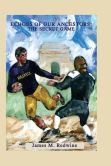
Those of you who have read my historical novel, Echoes of Our Ancestors: The Secret Game, know of the actual 1924 football game that was played in Osage County, Oklahoma between the Native American school boys from Haskell Indian Institute in Lawrence, Kansas and professional players from Kansas City. What was planned to be an exhibition game to encourage wealthy Osage and Quapaw Indians to contribute money for a new stadium at Haskell, became a gambling extravaganza where more than 200,000 dollars changed hands and thousands more were contributed for the stadium. The game was the brainchild of head Haskell football coach, Frank McDonald, whose exhibition spun out of his control when gamblers and grifters got involved.
Peg and I wrote and published Echoes in 2014 based on the memories of our Osage friends, Judy Taylor, her daughter Barbara nee Taylor Pease, and one faded newspaper article. However, I recently was with professional writer and photographer, Ryan RedCorn of Osage County, who happened to know a great deal about The Game and recommended a book by Coach Mc Donald about one of the all-time greatest Haskell football players, John (Big Skee) Levi, who starred in the Secret Game. Peg managed to find and order a rare copy of Coach McDonald’s book; it is interesting and well worth the $90 it cost. McDonald’s book explains why this 1924 game had to be played in secret and kept secret:
“This game played in the Osage Hills has to be one of the best kept secrets of all time. Not only would anyone who participated be declared professional but it most probably would have ruined the future(s) of Coach(es) Frank McDonald, Dick Hanley and assistant coaches. While the team was suiting up for the game I (Coach McDonald) was explaining to Fred Lookout (Principal Chief of the Osages) and his committee the serious aspects of what might happen to the Haskell Indians. They immediately lined up some scouts to police the crowd and report anyone who was taking notes. They found one newspaper reporter but the committee conferred with him and assured me he had been handled ‘Osage Style’. If anyone had showed up with a Brownie camera they might have been scalped.
The next morning when we changed trains at Ottawa (Kansas) to come on to Lawrence (Kansas) we had a station platform meeting with the team. We really painted a bleak picture of what might happen if the word got out. There would be firings of the coaches and expulsion of the players-and the worst-No Stadium.
Several years later in an appearance before the Rotary Club at Lawrence I revealed the secret of the ‘Game in the Osage Hills’.”
John Levi of Haskell by
Frank W. McDonald, pg. 48
Also, in McDonald’s book on pages 42-43 he referred to a September 20, 1970 article that appeared in the Star Magazine:
“FOOTBALL WITH A HASKELL WAR WHOOP
It was a real game of cowboys and Indians with thousands of dollars riding on the outcome.
The game was football and it is probably no exaggeration to say that $200,000 changed hands between oil rich Indians betting on the game. That was almost 46 years ago, and the lasting result can be seen today in the Haskell stadium at Lawrence, Kansas.
In upholding Indian pride that day, the Haskell team earned the hard cash gratitude of wealthy Osage and Quapaw tribesmen.
The 1924 football season had just ended. The Cowboys were the old professional football team. The Indians were from the Haskell Indian Institute. In theory it was a game between Fairfax, Oklahoma and Hominy, Oklahoma. The Cowboys were masquerading as Fairfax and the Haskell team was substituted en masse for the Hominy Giants.
Colleges all across the land had learned that crowds of people would happily pay to attend football games and the initial stadium building craze was on. Frank W. McDonald of Lawrence was in charge of raising funds for the Haskell stadium which was the third largest in the state when it was dedicated in October 1926.
It is now presumably safe, McDonald said recently, to acknowledge how one single football game, the secret, illegal, wildly improbable contest played in the late fall of 1924 in the rolling Osage hills west of Bartlesville, (Oklahoma) built the Haskell stadium.
No program listed the players and no newspaper chronicled the game, and it’s a good thing, in competing against professionals in an unsanctioned game, Haskell and its players were risking their eligibility. But the good-will Haskell engendered that day with the recently oil- and mineral-rich Osage and Quapaw Indians of Northeast Oklahoma unquestionably built the stadium.”
Gentle Reader, the purposes of this column are to reprise The Game and recommend both McDonald’s book and Echoes and also ask if anyone has any further information about The Game or maybe even has a surviving relative who could pinpoint where, “(I)n the rolling Osage hills west of Bartlesville”, the game was played. If so, please let me hear from you and Thank You!
Contact Info: P.O. Box 119, Barnsdall, OK 74002, jmredwine@aol.com or 918-287-8009
For more Gavel Gamut articles go to www.jamesmredwine.com
McDonald’s book is available online. Echoes of Our Ancestors: The Secret Game is also available from the internet, in Oklahoma at The Woolaroc Gift Shop, The Osage County Historical Society Museum, and Peg’s booth at The Great Exchange Flea Market in Pawhuska; in Indiana at Caper’s Emporium in New Harmony.